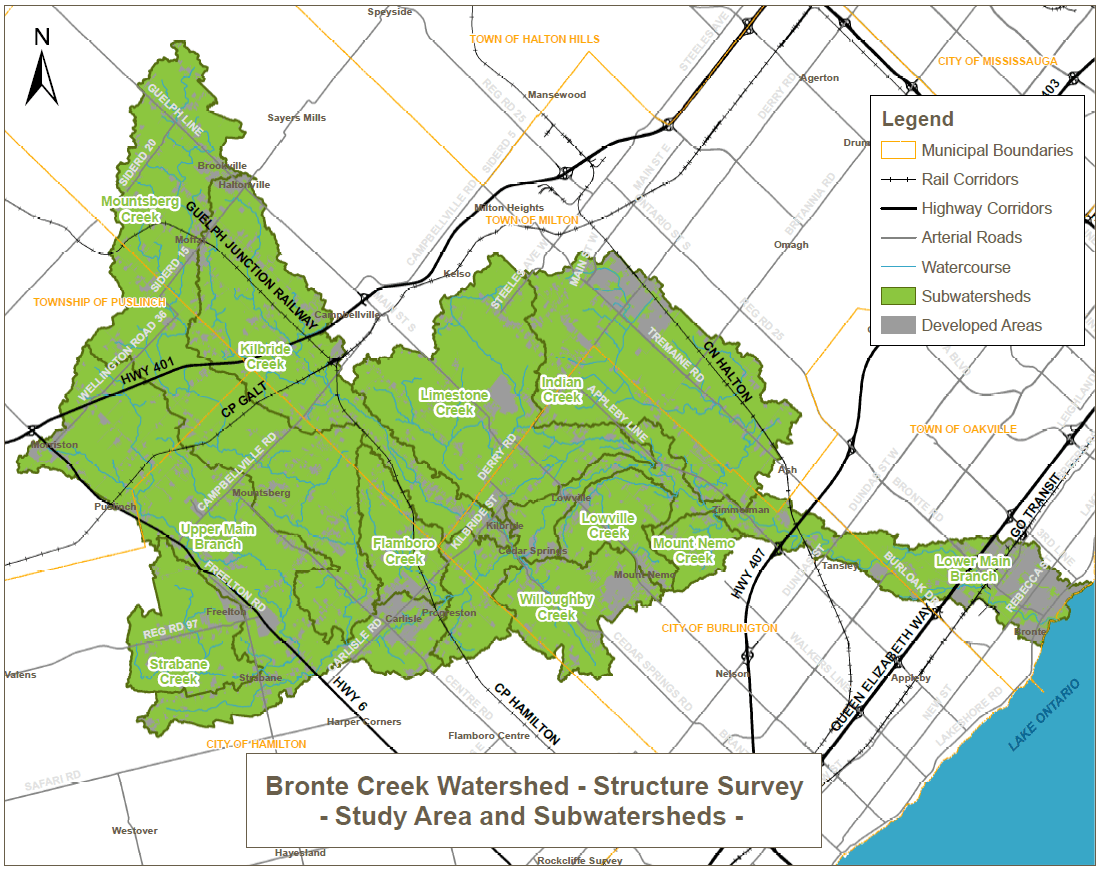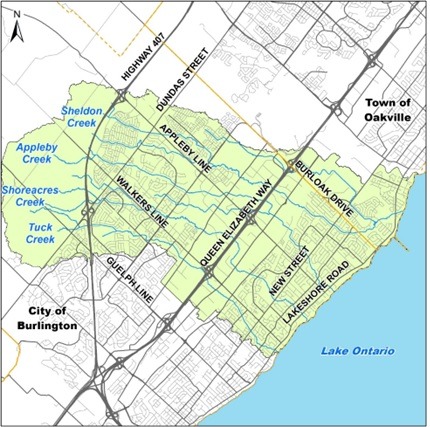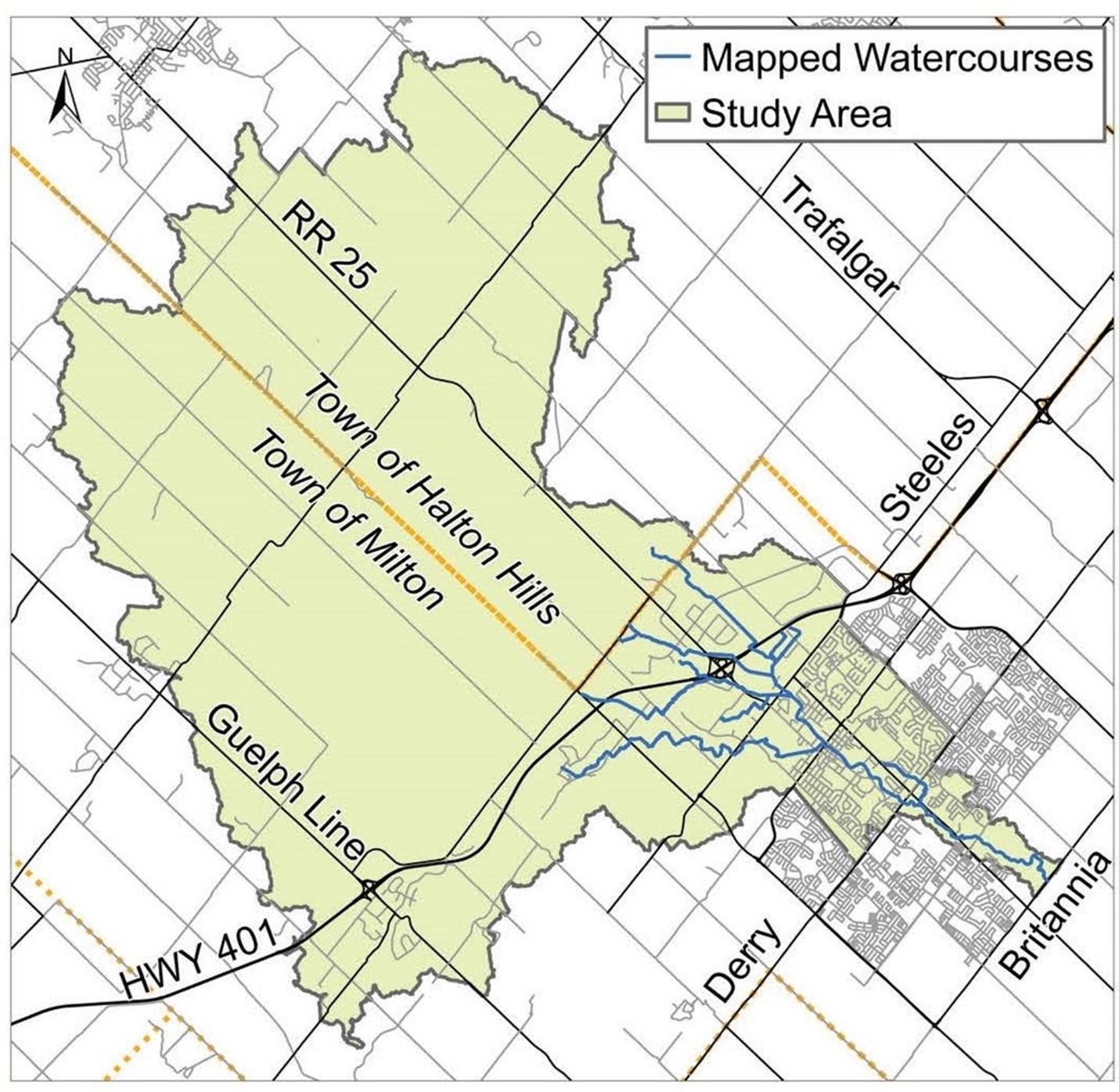آن لائن میپنگ ہمارے واٹر شیڈ کے بارے میں معلومات فراہم کرتی ہے، بشمول کنزرویشن ہلٹن پارکس اور دیگر پراپرٹیز، بشمول نیاگرا ایسکارپمنٹ اور گرین بیلٹ، نیز ہماری تقریبا ریگولیشن حد نقشہ سازی۔
گزشتہ چند سالوں کے دوران کنزرویشن ہلٹن نے ہماری ریگولیٹری میپنگ (جیسے سیلاب کے خطرے کی نقشہ سازی، ویٹ لینڈ میپنگ، واٹر کورس میپنگ وغیرہ) کا ایک بڑا جائزہ اور اپ ڈیٹ شروع کیا ہے۔ تکنیکی مطالعات اور ماڈلنگ کی اپ ڈیٹس، نئے آلات اور ٹیکنالوجیز کا استعمال کرتے ہوئے، ہمیں موجودہ خطرات اور/یا ویٹ لینڈز کی نوعیت اور حد کو بہتر طور پر سمجھنے میں مدد کرتی ہیں۔ نقشہ سازی ایک متحرک عمل ہے۔ جیسے جیسے نقشہ سازی کے جائزے اور اپ ڈیٹس پیش رفت ہوتی ہیں، تخمینہ ضابطہ حد نقشہ سازی میں تطہیر ضروری ہوگی، کیونکہ اضافی خطرے یا منضبط علاقوں کی شناخت یا ہٹایا جاسکتا ہے۔
PLEASE NOTE: On فروری 16, 2024, the Province introduced O. Reg., 41/24, which alters the boundaries of CH’s regulated area. Conservation Halton is in the process of updating its Approximate Regulation Limit mapping for اپریل 1, 2024. Learn more on our Permitting and Planning page.
The Floodplain Mapping program is responsible for updating and maintaining watershed floodplain mapping, which identifies flood risk and hazards. This information is used to develop approximate regulation limit mapping for purposes of review associated with the Conservation Authorities Act and Ontario Regulation 41/24, as well as used to support flood risk management decisions and communications
ایک کمیونٹی کے اندر سیلاب سے ہونے والے نقصان کے اثرات کو کم کرنے کا پہلا قدم نقشہ سازی کرنا ہے جو ہمیں سیلاب کے خطرات کی درست شناخت کرنے میں مدد کرتا ہے۔ کنزرویشن ہلٹن ہمارے شراکت داروں کے ساتھ مل کر ہمارے فلڈ پلین نقشوں کو اپ ڈیٹ کرکے ہماری کمیونٹیز میں سیلاب کے خطرے کو کم کرنے کے لئے کام کر رہا ہے جن میں سے کچھ 20 سال سے زیادہ پرانے ہیں۔ تکنیکی مطالعات اور ماڈلنگ کی اپ ڈیٹس، نئے آلات اور ٹیکنالوجیز کا استعمال کرتے ہوئے، ہمیں سیلاب کے خطرات کی حد کو بہتر طور پر سمجھنے میں مدد کرتی ہیں۔ جیسے جیسے نقشہ سازی کے جائزے اور اپ ڈیٹس پیش رفت ہوتی ہے، تقریبا ریگولیشن کی حد کی نقشہ سازی میں تطہیر ضروری ہوگی، کیونکہ اضافی خطرے یا منظم علاقوں کی شناخت کی جاسکتی ہے اور کچھ کو ہٹایا جاسکتا ہے۔
آپ اس میں کیسے شامل ہو سکتے ہیں؟
کنزرویشن ہلٹن عوام کو سیلاب کے خطرے کی نقشہ سازی کے مطالعے میں حصہ لینے کی ترغیب دیتا ہے۔ عوامی شمولیت فلڈ پلین میپنگ پروگرام کے لئے زیادہ یقینی اور شفافیت فراہم کرتی ہے، اور اس سے ان لوگوں سے واٹر شیڈ کے بارے میں مشاہدات حاصل کرنے سے فائدہ ہوتا ہے جو ان واٹر شیڈ حالات کا تجربہ کرتے ہیں۔
ہم فلڈ پلین میپنگ مطالعات پر عوامی مشغولیت کے اجلاسوں کی میزبانی کرتے ہیں تاکہ عوام اور اسٹیک ہولڈرز کو مطلع کیا جاسکے کہ ان کے علاقے میں ایک مطالعہ ہو رہا ہے اور جائزہ اور ان پٹ کے لئے مطالعاتی عمل اور مسودہ نقشہ سازی اپ ڈیٹس کے بارے میں معلومات کا اشتراک کریں۔ فلڈ پلین میپنگ مطالعاتی نوٹیفکیشن اور عوامی مشغولیت سے متعلق اپ ڈیٹس کمیونٹی اخبارات میں شائع کی جاتی ہیں اور کنزرویشن ہلٹن ویب سائٹ اور سوشل میڈیا پر پوسٹ کی جاتی ہیں۔ براہ راست اطلاعات حاصل کرنے کے لئے مطالعہ کے لئے آپ ای میل رابطہ فہرست میں شامل کرنے کی درخواست بھی کرسکتے ہیں۔
Conservation Halton developed a protocol to establish at what point in the mapping update process will the draft data or mapping be considered “best available information” for understanding the extent of the hazard, assessing potential risk to life and property, identifying potential interference to a wetland, identifying areas requiring further analysis, making decisions when development is contemplated in hazardous or regulated areas and administering the Ontario Conservation Authorities Act and Ontario Regulation 41/24. The Mapping Implementation Protocol establishes the key stages in the mapping update and study process, what data will be used at each stage of the process, how the data will be presented in online mapping, when the data can be used for administering the Conservation Authorities Act and Ontario Regulation 41/24, and when public and stakeholder engagement will occur.
The Conservation Halton Board endorsed the Mapping Implementation Protocol Report for use on نومبر 26, 2021.
حالیہ نقشہ سازی مطالعات:
 Watercourse crossing structures like bridges and culverts can significantly impact flooding along rivers and creeks. To better understand the impacts of these structures, Conservation Halton collected data within the Bronte Creek watershed from مئی 2023 to فروری 2024. This data will inform future updates to Conservation Halton’s flood hazard mapping.
Watercourse crossing structures like bridges and culverts can significantly impact flooding along rivers and creeks. To better understand the impacts of these structures, Conservation Halton collected data within the Bronte Creek watershed from مئی 2023 to فروری 2024. This data will inform future updates to Conservation Halton’s flood hazard mapping.
Flood hazard mapping is an important tool that supports Conservation Halton’s regulatory, planning, and flood forecasting programs. This information also supports municipal emergency management planning, and flood mitigation and infrastructure design.
Public engagement sessions and opportunities for the public to learn more about Conservation Halton’s flood hazard mapping for Bronte Creek will occur once a study formally begins.
This structure survey project received funding from the Government of Canada through the Flood Hazard Identification and Mapping Program (FHIMP), a component of Canada’s National Adaptation Strategy. The FHIMP is led by Natural Resources Canada (NRCan) and provides funding to Provincial and Territorial governments in partnership with Environment and Climate Change Canada and Public Safety.
Project geodatabases are available upon request.
If you have any questions, comments or concerns, please email floodplainmapping@hrca.on.ca.
 Conservation Halton has updated flood hazard mapping for Tuck, Shoreacres, Appleby, and Sheldon Creeks in your community.
Conservation Halton has updated flood hazard mapping for Tuck, Shoreacres, Appleby, and Sheldon Creeks in your community.
Flood hazard mapping is an important tool that supports Conservation Halton’s regulatory, planning and flood forecasting and warning programs, as well as municipal emergency management, flood mitigation, and infrastructure design. Advances in technology allow us to understand flood risks and develop better flood hazard mapping.
Flood hazards include floodplains and spills. A floodplain is an area of land that is flooded with water by a nearby creek or lake during large storms. Spills occur when flood waters leave the valley and floodplain and “spill” into surrounding lands, rejoining the watercourse at a distance downstream or moving into another watershed.
One of Conservation Halton’s top priorities is to protect life and property from natural hazards and updating hazard mapping is one of the ways we do that.
In 2021, Conservation Halton retained the engineering consulting firm WSP, to update the flood hazard modelling and mapping for Tuck, Shoreacres, Appleby and Sheldon Creeks which cross through parts of east Burlington and southwest Oakville (referred to as ‘East Burlington Creeks Flood Hazard Mapping Study’). Updated mapping and modelling provides Conservation Halton, municipalities, the public, and stakeholders with a current understanding of the magnitude and extent of riverine flood hazards in this area. The study also provides background information and technical details about how the riverine flood hazard modelling and mapping was updated.
As part of this study, Conservation Halton hosted two public engagement sessions. The first engagement session occurred in اکتوبر 2021 to provide notification of study commencement. This engagement session also provided an opportunity for property owners, residents and other stakeholders to ask questions and share feedback. Draft final mapping was shared during the second virtual engagement session held on جون 6, 2023.
Presentation material from the final public engagement session is available here: East Burlington Creeks Food Hazard Mapping – Final Consultation.
If you have any questions, comments or concerns, please email floodplainmapping@hrca.on.ca.

Updates to technical studies and new flood hazard modelling can help us better understand the nature and extent of existing flood hazards. These updates can also result in changes to hazard and conservation authority regulation mapping.
The City of Burlington recently completed a Phase 2 Flood Hazard and Scoped Stormwater Management Assessment for downtown Burlington and the Burlington GO Major Transit Station Area (MTSA). The Phase 2 study is considered the best available information for decision making when development is contemplated in hazard lands.
Conservation Halton’s approximate regulation limit mapping has been updated to reflect the Phase 2 study findings.
Under the Conservation Authorities Act and Ontario Regulation 41/24, Conservation Halton regulates all watercourses, valleylands, wetlands, Lake Ontario and Burlington Bay shoreline and hazardous lands, as well as lands adjacent to these features. Permission is required from Conservation Halton to undertake development within these areas.
| For more information about Conservation Halton’s regulated areas and your property, please contact:
Email: floodplainmapping@hrca.on.ca Phone: 905-336-1158 ext. 2296 |
For more information about the Phase 2 Study, please visit:
http://getinvolvedburlington.ca/mtsa Email: mtsa@burlington.ca | Phone: 905-335-7600 ext. 7426 |
 Conservation Halton has retained consulting and engineering company, Greck and Associates, to update flood hazard mapping and modelling for the West Branch of Sixteen Mile Creek in the Town of Milton. Advances in technology allows us to better understand flood hazards and to develop more accurate floodplain mapping. One of Conservation Halton’s top priorities is to protect life and property from natural hazards and updating flood hazard mapping is one of the ways we do that. An important part of the process of updating flood hazard mapping is to inform and engage with residents and other stakeholders in the study area.
Conservation Halton has retained consulting and engineering company, Greck and Associates, to update flood hazard mapping and modelling for the West Branch of Sixteen Mile Creek in the Town of Milton. Advances in technology allows us to better understand flood hazards and to develop more accurate floodplain mapping. One of Conservation Halton’s top priorities is to protect life and property from natural hazards and updating flood hazard mapping is one of the ways we do that. An important part of the process of updating flood hazard mapping is to inform and engage with residents and other stakeholders in the study area.
Flood hazard mapping is used by Conservation Halton and municipal partners to identify areas that may be susceptible to riverine or shoreline flooding, and to inform flood forecasting, emergency response, community planning, infrastructure upgrades and other flood prevention efforts. Flood hazards include floodplains and spills. A floodplain is an area of land that is flooded by a nearby creek or lake during large storms. Spills occur when flood waters leave the valley and floodplain and “spill” into surrounding lands, rejoining the watercourse at a distance downstream or moving into another watershed.
As part of this study, Conservation Halton hosted three public engagement sessions. The first engagement session occurred in اکتوبر 2019 to announce the study. A second engagement session in مارچ 2020 presented high-level draft results. The final engagement session in فروری 2023 shared the detailed draft final mapping. Presentation material from the final public engagement session is available here: Urban Milton Flood Hazard Mapping—Final Consultation.
If you have any questions, comments or concerns, please email floodplainmapping@hrca.on.ca.